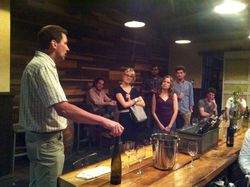By Evan Dawson, Finger Lakes Editor
 On special occasions, Anthony Road Wine Company winemaker Johannes Reinhardt hauls out a long, unlabeled bottle. It's marked only with the letters "SP." Those letters represent one important and potentially game-changing word.
On special occasions, Anthony Road Wine Company winemaker Johannes Reinhardt hauls out a long, unlabeled bottle. It's marked only with the letters "SP." Those letters represent one important and potentially game-changing word.
Spontaneous.
In 2009, Reinhardt decided to experiment with natural, or spontaneous, fermentation. He created a small batch of riesling, only 80 cases, for the purpose of studying the differences between the usage of cultivated yeast and native yeast.
This is a small step, but potentially one with large implications for the Finger Lakes wine industry. Anthony Road is a leader in riesling quality, and if this project turns out to be successful, it would not be surprising to see other producers follow suit.
But that's getting ahead of ourselves.
"Taking off the uniform"
Most Finger Lakes winemakers use cultivated (or "commercial") yeast to guide fermentations. Reinhardt has always done the same. Part of his desire to experiment with native yeast comes from his curiosity about what other characteristics might emerge in Finger Lakes wines.
"Cultivated yeast provides a kind of uniform," he says. "The wines might show similar characteristics, similar aromas and flavors. There's nothing wrong with that. But natural yeast removes the uniform, let's say it that way."
The result from his first effort with native yeast presents a kind of riesling that is markedly different. With 16 grams of residual sugar but blessed with high acidity, it's a wine that straddles dry and semi-dry. Johannes noticed the changes immediately.
"It's just different," he says. "It doesn't have the notes of sweeter fruits in the nose, no banana or pear, for example. There is a different set of aromas. And in the mouth it is quite different. There is this intriguing structure, more grip, a very interesting texture. There is more weight and good tension."
This riesling will become one of a small handful of wines in the region to be made in this method. Bloomer Creek uses spontaneous fermentation, and Hermann J. Wiemer uses less cultivated yeast than most. Reinhardt referred to the Wiemer method as "an inspiration."
Reinhardt explains that using native yeast might allow the wines to better display vintage variation. "I would expect that to be the case, and I hope that's the case," he says. "I'm someone who enjoys seeing the differences from year to year, and I do wonder if cultivated yeast helps mask those differences."
Many of the best wines of Germany are made with native yeast, and that fact is not lost on Reinhardt, a German with great respect for his home country.
 "It will take years to get comfortable"
"It will take years to get comfortable"
Despite Reinhardt's enthusiasm for this project, he is humble about the early results. After producing 80 cases of spontaneously fermented riesling in 2009, Reinhardt produced 102 in 2010 and is aiming to make closer to 200 in 2011, along with some gewurztraminer.
"But that's still a small amount of wine, you know?" he says. "Nothing has gotten out of hand so far, so that's good. But it'll take years go get comfortable, probably five or six or seven years for me."
In 2009, Reinhardt had to exercise patience, "which is not always easy for a German to do," he explains. After clarifying the juice, Reinhardt prepared it for fermentation and then waited. "After a week, nothing," he says. "After two weeks, still nothing. I was not nervous because I knew the juice would do what it wanted to do. But after three weeks, you could finally hear the fermentation taking place. It had started on its own."
In 2010 he only needed to wait seven days for the fermentation to begin. And despite the occasional association of natural wine with some of the wilder aspects of winemaking, Reinhardt insists that cleanliness is key. "You simply must have a clean facility, and you have to fill your tanks," he says, explaining that full tanks will ward off early oxidation.
Ultimately, Reinhardt can envision making most of his wine in this method. "But that's a long road to go," he says with a smile. "I'm just trying to gain experience. I have so much to learn."
First release coming soon
Don't ask Reinhardt if he thinks wine made with spontaneous fermentation is better. He says it's far too soon to know — and he will continue to use cultivated yeast in most of his winemaking for now. After all, some of the most highly regarded wines in the world are made with cultivated yeast. "There's no right or wrong here," he says. "I think we're all just trying to do the best we can."
The Anthony Road 2009 Spontaneous Fermentation Riesling will be released in September, Reinhardt says, likely for around $20. They will have to figure out what to call it. Reinhardt might downplay its significance, but for a producer of Anthony Road's stature, everyone will be watching and tasting this riesling.
